
Please be aware that some specialist imagery may take time to load.
This site is designed for dedicated researchers on desktop or tablet, not ideal for mobile browsing.
and the follow-on Post War Mossberg 46 M (b)
See also: imagery only (as yet) of the Model 44 US (d)

Just two years into the 1939-45 War, Britain was suffering a serious shortage of suitable training rifles.
With all local manufacturers committed to the far higher priority of Service arms production,
there were simply not enough small calibre rifles to go round.
Local Defence Volunteer units (latterly the Home Guard)
were utilising almost anything on which they could lay their hands,
and such small-bore rifles as were in stock with gunsmiths or manufacturers were taken over
by the War Office for distribution anywhere they might be of value for economical training purposes.

The U.S.A. were already supplying much miltary matériel,
and a request was made for a consignment of .22 rimfire rifles suitable for the purpose.
The Mossberg Model 42 rifle was a sporting/target based design
which offered an excellent basis on which minor modifications
could comparatively easily be made to current production lines;
the substitution of the three-quarter length stock with a full-length
military style stock being the most significant and obvious.

The initial contract, in June 1941, was for 10,000 rifles. Previous to this date,
Mossberg had used only a letter code on their production rather than serial numbers.
Arranging to add the serial numbers required by the British Government took time,
and the first 2,500 rifles left the factory not so marked.
Thus the latter three-quarters of that contract ran from serial number 2501 to 10,000,
and no earlier numbering should be seen.
There was, not surprisingly, a delay in the despatch of this early batch due to the numbering requirement.
There were further contracts for rifles over the next eighteen months; a batch of 8,000 later in 1941,
another 20,000 in March 1942, spares in June, and two more batches of rifles, totalling 8,000, early in 1943.
Precise numbers allotted between U.S. and British destinations
Incidentally, the "M" in the rifle's nomenclature is reputed to be for "Mannlicher",
being the style of stocking used, with the pistol-grip wrist.
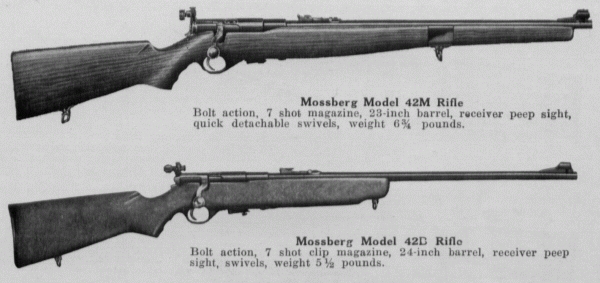
The Parker-Hale post-war advertisement quotes the 42M rifle as having a barrel length of 23 inches,
and a weight of 6 lbs. 12 ozs. The magazine had a 7-round capacity, and a spare magazine was sometimes
to be found in a compartment in the butt, accessed via a butt-trap.
The magazine's latch release is at the rear of the base plate, and a knurled knob,
an unusual fitment for the adjustment of the follower's spring pressure, is at the front.
The knurled knob is the removeable short adapter for a Mossberg R119 7rd magazine.
The R118 magazine did not have a short adapter - the floor plate was not drilled and tapped.
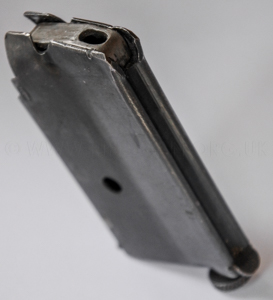 .........
.........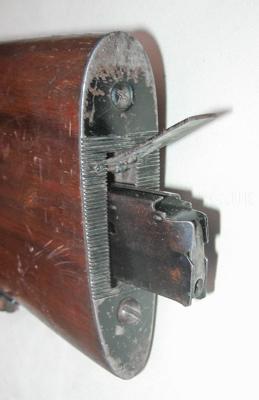 .........
.........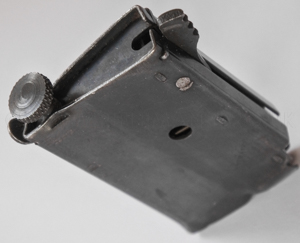
The fore-sights on the British contract rifles were also tunnelled,
but that tunnel was slightly shorter and on a shorter ramp.
The tunnelled sight itself was not dissimilar in outward appearance
to that fitted on the Ross Cadet nearly thirty years earlier,
although the addition of a pressed steel ramp shroud modernised the look.
The small pull/push ring at the right-hand-side of the pressed steel ramp
permits lateral adjustment of the integral blade element.
Mossberg made two nearly identical 'stamped' front sights, the S106 and S101.
Both front sights included four user-selectable sight posts;
a narrow post, wide post, disc post and ghost ring.
The protruding blade in the photo below the 'ghost ring.
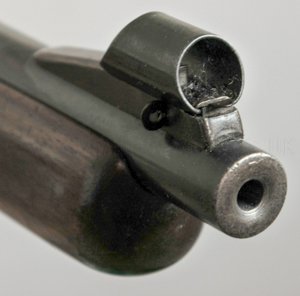
These rifles were originally only fitted with a barrel mounted S102 tangent rear-sight, shown below.
The illustrated example is missing its elevation adjustment screw.
 ...............
...............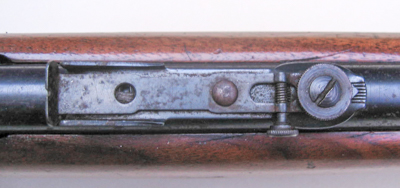
However, the British early contract rifles had the Mossberg S104 receiver mounted
aperture sight added to emulate the rear-sight of the Lee-Enfield No.4 Rifle.
It has to be said that the Mossberg was a very light-weight representation of the No.4 rifle,
and far less realistic than other training
- the best of which were simply small-bore versions of the parent service rifle,
such as the SMLE No.2 MkIV* and the later No.7 Rifle -
- but, at that time, it was a case of "needs must when the Devil drives".
The rear sights shown in the Parker-Hale advertisement earlier on this page
are those S104 models fitted to the rifles for the U.S. home market, as illustrated below.
The safety-catch lever below the bolt-way is in the firing position,
indicated by its location above the red "F" lettered stud.
The safe position would be with the catch lever slid to the right, above the green stud lettered "S".
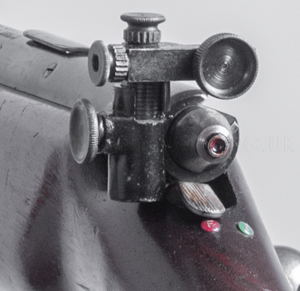 ...............................................
...............................................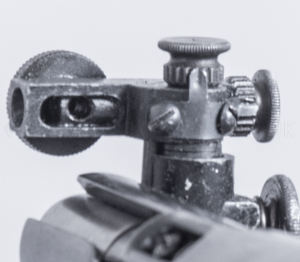
The rear aperture sight used by Mossberg was acknowledged to be rather fragile,
it not having been designed for service-style use.
Many were damaged, and Parker-Hale modified one of their "Sportarget" rear-sights
with a bracket to fit the left-hand side of the Mossberg receiver.
These sights were fitted, post-war, to many of those rifles
which escaped return to the U.S.A. under the Lend-Lease contract terms.
Such rifles are easily identified by the stampings
"UNITED STATES PROPERTY "
on both the barrel and the receiver.
A particularly unusual aspect of the 42M-B rear-sight arrangement
was a Royal Small Arms Factory (Enfield)
adapter that could be used for training on "Harmonised" targetry.
The Archives of the National Firearms Collection (originally part of the Enfield Pattern Room),
hold an Enfield drawing (Ref. No. D.D. (E). 3582) of the adaptation,
that allowed the rear sight aperture to be raised to a height that moved the Point of Impact up
by approximately 27 inches for shooting on Landscape targets.
Aim was taken at the point on the landscape picture
that was indicated by the Fire Direction of the Range Officer,
but the strike was on a "Skyscreen" above,
to retain the integrity of the expensive printed landscape.
A pendulum scoring device was used to assess the scores of the shooting party.
See: LANDSCAPE TARGETRY
The design was "sealed" on 16th. February 1944.
The rifle had been given the nomenclature "U.S.A. Mossberg .22-in Rifle, Mark I"
This drawing, and many images on this page, are copyright both to the Royal Armouries and to www.rifleman.org.uk
We had never seen one of these adapted sights in the flesh, and asked if any reader may have more information.
Thus far, we had heard nothing; and it appears that the sight adaptor is in the league of hens' teeth,
but a member of the Rimfire Central Forum of the U.S.A.
recently engineered a precise replica from the old Pattern Room drawing above,
and very kindly passed us photographs of the unit attached to the S104 sight on an original rifle.
These afford a view of the arrangement that it would otherwise not be possible to see.
Below: the adaptor attached to the S104 windage arm by the special knurled eye-piece,
the extended thread of which passes through the arm into the windage slide.
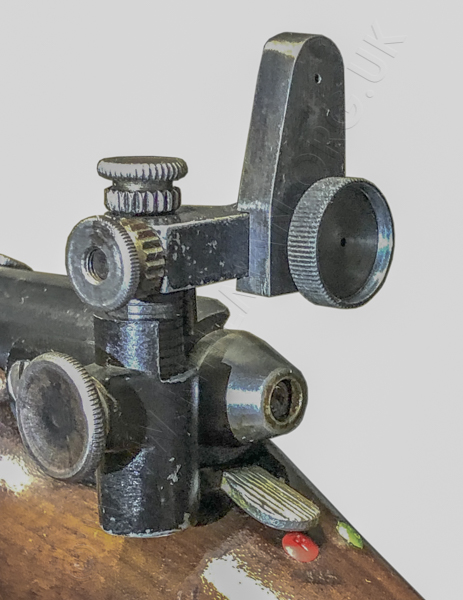
Below: the adaptor and its eye-piece ......
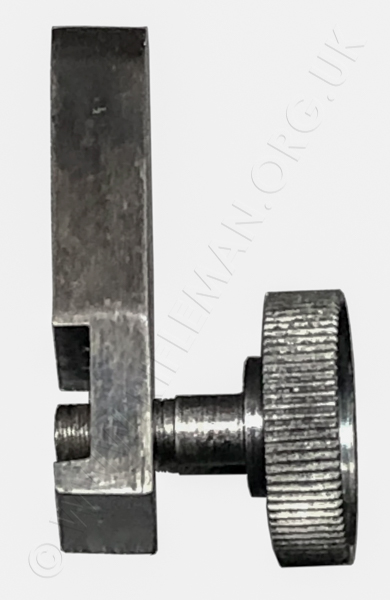
........ and the attached unit viewed from the front, showing the eye-piece threaded into the windage slide.
Note that the adaptor's machined channel is therefore a sliding fit on the windage arm.
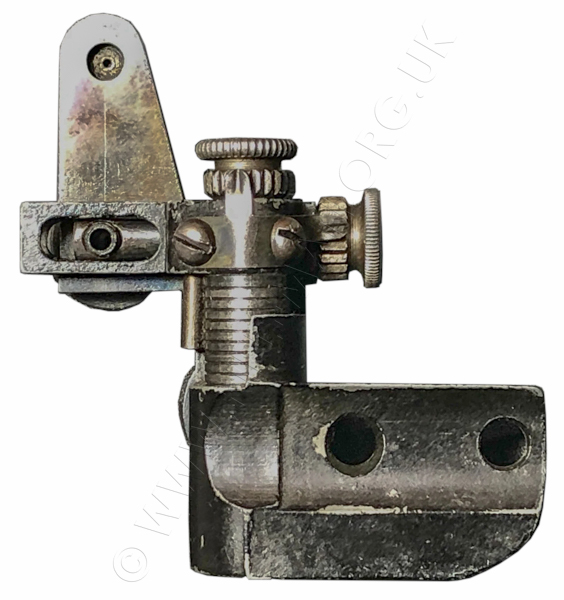
We thank Terry for his fine work.
Parker-Hale's 1946 post-war catalogue offered alternative fore and rear sights.
The page read as follows:
The No. 42 M.B. Mossberg rifles imported from U.S.A. in large numbers
during the war for preliminary training are notoriously weak in their sighting equipment,
so to meet the demand for more serviceable sights, we offer :—
MOSSBERG RAMP FORESIGHT with hood and screw
for .22" calibre Mossberg rifle model 42 M.B.
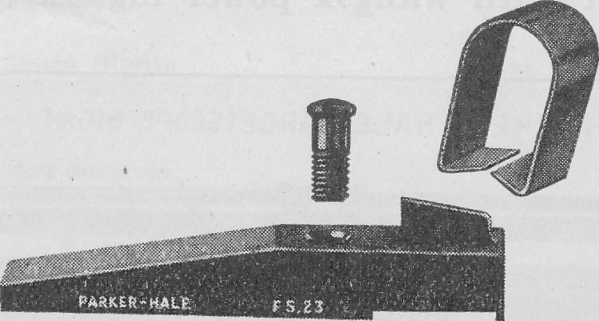
List Number FS.23 Price 9/–
Postage 3d.
Spare parts : foresight block - 7/6
Steel protector fixing screw - 2/6d.
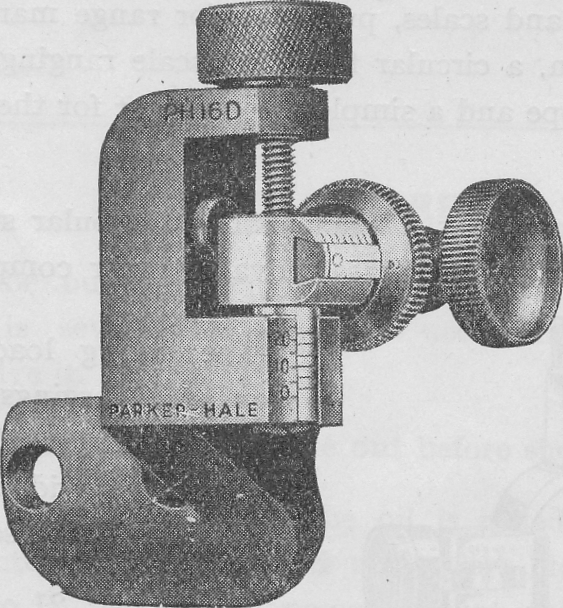
The PARKER-HALE SPORTARGET APERTURE BACKSIGHT - PH 16 D
for .22" calibre Mossberg rifle model 42 M.B.
This rifle is worthy of good sighting equipment, so we have adapted our Receiver type Sportarget aperture backsight to replace the original frail and unsatisfactory aperture backsight provided by the makers.
The Sportarget sight has clear scales for vertical and lateral adjustments with distinct clicks for each half minute. A half minute click makes a movement on the target of 1/8th of an inch on a 25 yards range, which is fine enough for the most expert rifleman. It is supplied with two screws to fit existing screw holes.
List No. PH.16D with single hole eyepiece Price 43/–
Ditto. with midget six hole eyepiece Price 50/–
The rifle shown below is fitted with the PH 16 D rear-sight
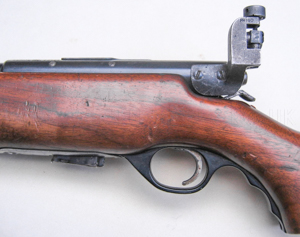 ..........................
.......................... 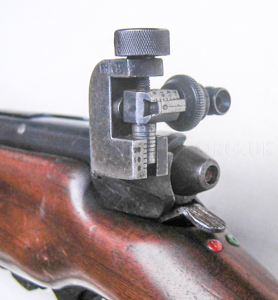
Detail of the difference in the mounting machine screws for the original Mossberg and replacement P-H16D sight are HERE
_______________________
The sling-swivel arrangements are unusual when compared with most British small-bore training or target rifles.
The round stud, in which the swivel loop rotates, has a key under,
which locates in the keyed slot in both the forward "barrel band"
(which band does not actually encompass the barrel), locking into place with a 90 degree twist.
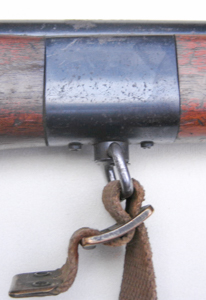 ..................
.................. 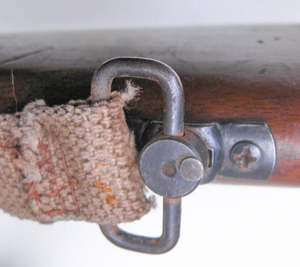
An interesting feature is the use of cross-head "Phillips" type screws to mount the fittings,
in common with the screws used to fasten the butt-plates of the 42 MB (a) and 46 M (b) rifles,
the original 42M-B using traditional slotted screws.
Whilst Thompson patented the Phillips screw in 1932, their use in the firearms trade is unusual to this day,
and their inclusion in the specification of the Mossberg training rifles must have been amongst the earliest.
The steel butt-plate of the 42M-B has already been illustrated, but here on the left is the plastic fitting of the 42 MB (a),
being similarly used on the Model 46 MB, and to the right a further image of the 42M-B's sight line.
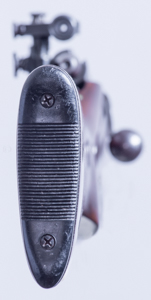 .............................
............................. 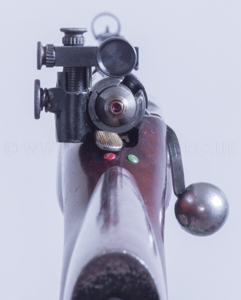
The rifles have two bedding bolts, one through the trigger-guard in front of the magazine,
and the other just behind the nose of the fore-end wood.
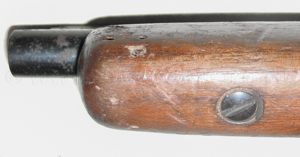
As already mentioned, in 1941 Mossberg received the first government contract for this .22 rimfire calibre training rifle.
Mossberg 42M-B Rifle Production Table |
||||
DATE |
CONTRACT No. |
QUANTITY |
PRICE (US Dollars) |
SERIAL Nos. |
30th. June 1941 |
DAW-478-ORD-9 |
10,000 |
10.00 |
2501-10000 |
12th. June 1941 |
DAW-478-ORD-187 |
8,000 |
12.00 |
10001-18000 |
27th. March 1942 * |
DAW-478-ORD-439 |
20,000 |
13.49 |
18001-37999 |
1st. January 1943 |
W-478-ORD-3077 |
5,000 |
" |
38001-43000 |
1st. March 1943 |
W-478-ORD-3239 |
3,000 |
" |
43001-46000 |
* This particular contract was held in abeyance for the commencement of serial numbering of the rifles.
During the 1943 contracts, a number of rifles with a modified extractor
had their 42M-B markings suffixed with an "a".
Additionally, the 42 MB(a) example to which we have access no longer
has the steel butt-plate with the trap for the spare magazine.
A moulded composite has replaced the steel fitment of the 42M-B,
and the spare magazine trap has been deleted from the specification.
The barrel of this modified rifle is stamped with the serial no.,
........... and the familiar "UNITED STATES PROPERTY", above the sling swivel band,
Mid-barrel is the company stamp with the rifle reference "42 MB (a)",
and on the front of the action is repeated "UNITED STATES PROPERTY" and the serial no.
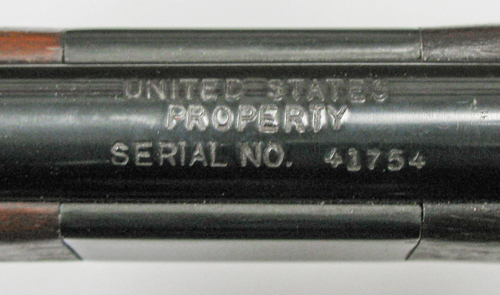 .........
.........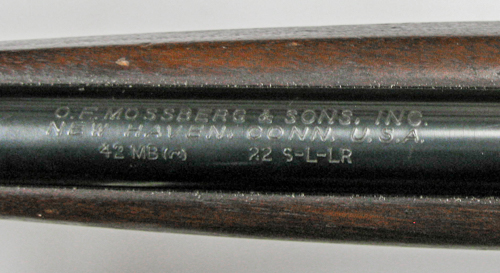 ........
........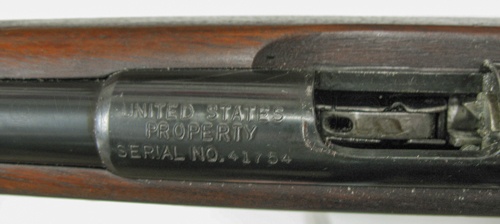
As we cover three rifles models on this page, we show a comparison image of their respective bolts.
The middle bolt has had the dust-cover removed in the past.
Left: the 42M-B ; centre the 42MB (a) ; right: the 46 M (b)
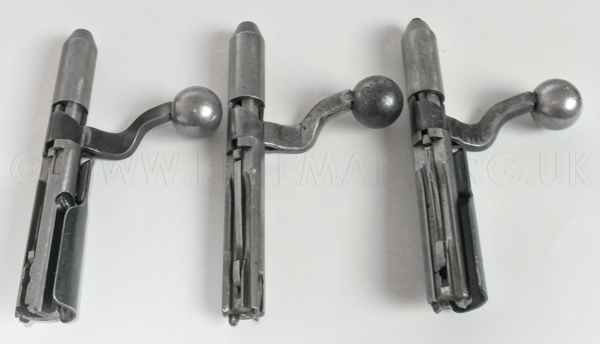
Below are close-up shots of the bolt-head faces to illustrate the differences in extractors, firing-pins,
and the cut-outs in the latter two, presumed to be gas vents in case of split cartridge-cases on firing.
The dust covers would therefore be added protection for the firer in such an event,
and are probably best left in place, although some shooters removed them,
considering them to be obstructive when loading.
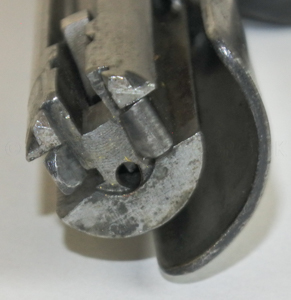 ..........
.......... 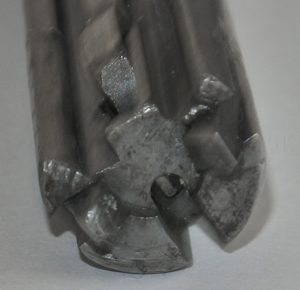 ..........
.......... 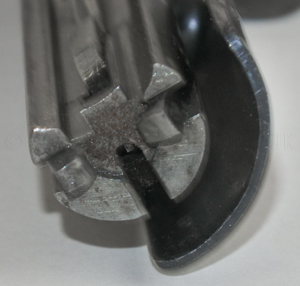
For reference, we also show each barrel's model identification marks for the three rifles, in the same order.
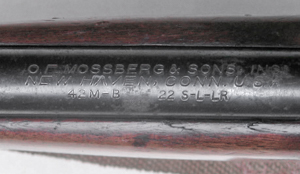 ......
...... ......
......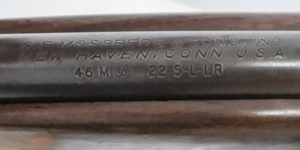
The parts list and breakdown drawing are shown belown
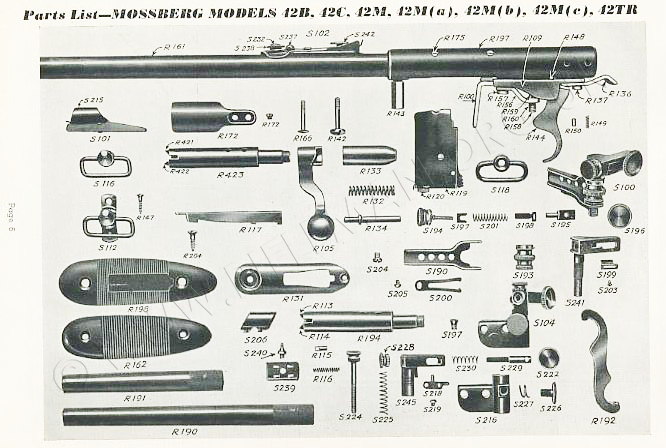
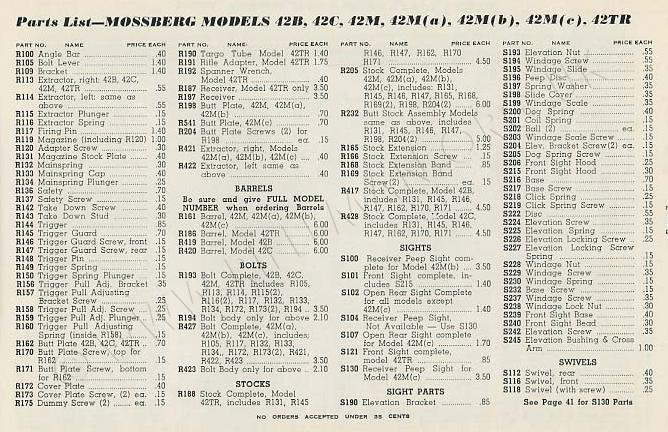
A little known, and frankly surprising appearance of
the Mossberg 42MB(a) rifle was after the War when a small number
were discovered in an armoury in Colombo in Ceylon (now Sri Lanka).
These had been fitted with the late 1930s model MM1
of the Parker-Hale small-bore moderator,
and were surreptitously issued for use by the Special Operations Executive
(S.O.E.) units of the near Colombo base.
The base was initially set up for SOE personnel active throughout South East Asia.
Their headquarters were in the central city of Kandy,
but there was a training facility at the Mount Lavinia Hotel in Colombo on the West Coast.
One of these rifles resided in the Enfield Pattern Room Collection,
now transferred to the National Firearms Collection at the Royal Armouries in Leeds.
We are grateful to the Trustees and curators respectively for permission
and opportunity to photograph the weapon, along with many others to be seen on this site.
silenced_SOE-02.jpg)
silenced_SOE-01.jpg)
The threaded portion of the muzzle closes the rear of the silencer to within an inch of the fore-end,
and little more than an eighth-of-an-inch from the front face of the fore-sight mounting block.
silenced_SOE-12.jpg)
The square-ended early silencer carries the Parker-Hale logo and triangular "Made in England" motif. Further detail of these can be found HERE.
The later post-War production had a bevelled rear end circumference.
There was a suggestion that the rifles found in Colombo had no British markings,
to prevent association with the British Government and Forces if captured.
Parker-Hale products had been marketed World-wide between the First and Second World Wars,
and and it could have been argued that the discovery of one on a rifle meant nothing politically.
silenced_SOE-05.jpg)
However, having been acquired under the Lend-Lease arrangement,
they all carried the usual U.S. Property markings on both the receiver and barrel.
silenced_SOE-07.jpg) ........
........ silenced_SOE-09.jpg)
Additionally, dated for 1942, the NFC example bears an Enfield inspection mark.
silenced_SOE-10.jpg)
The barrel has the usual roll-stamping of the Mossberg company,
including the "42-MB (a)" mark along with the familiar "S-L-LR" calibre mark
showing its suitability for the Short, Long and Long Rifle cartridges.
silenced_SOE-08.jpg)
The magazine is missing ..........
silenced_SOE-04.jpg)
........... and the rifle is fitted with the Parker-Hale alternative PH16 rear aperture sight.
silenced_SOE-03.jpg)
The early Enfield Pattern Room identifying label is still on the rifle,
although the later perspex tag, applied when the collection moved
to the Royal Small Arms Factory at Nottingham, remains attached to the butt's sling-swivel.
silenced_SOE-11.jpg)
A recent discovery by an historical research team, members of the "Bulbasket" WW2 Living History Group, to be found on Facebook, was as a result of one of their visits to the region of Verrieres in France, which held the area of woodland in which a Special Air Service's party was camped during the Second World War. Operation Bulbasket was an infiltration also involving the French Resistance, but the SAS group's whereabouts were given away to the Nazi occupiers by a traitor, and the members were rounded up and imprisoned. Several were wounded in fighting for their survival, as it was well known that Hitler had decreed that any captured Commando or other clandestine Allied troops were to be executed as spies. The walking survivors were all shot, and those initally taken to hospital were executed by lethal injection. There were repercussions post-war, but convictions of war crimes by the Nazis believed involved were limited and barely successful.
The relevance of this subject appearing here is that the research team, who also carry out memorial activities for those brave servicemen who were active in the operation, came across an old photograph believed to have been taken at the SAS encampment in the woods. This shows one of the SAS team relaxing between sorties, with a Mossberg 42MB rifle resting on his nearby kit.
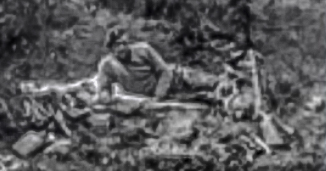
The rifle carries the U.S. issue S104 aperture rear-sight,
but it is not possible to tell whether the muzzle has been screw-cut for a moderator
as were those used by S.O.E. in Colombo.
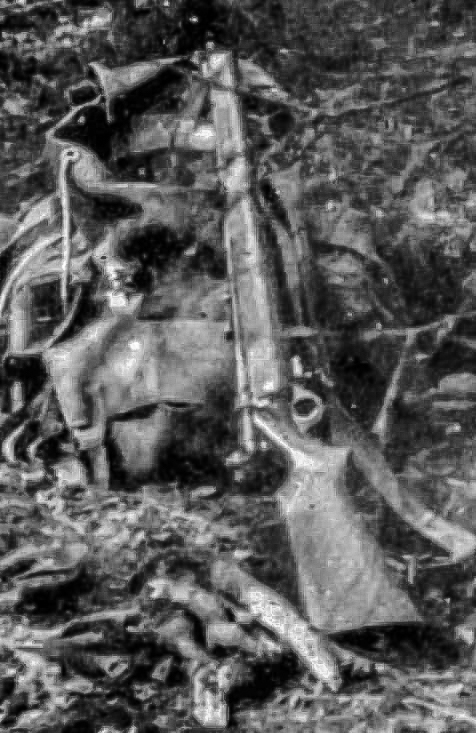
The Facebook research group puts forward the not entirely unreasonable suggestion that these rifles found in that SAS scenario were potentially used as assassination weapons. That may have been true in very occasional circumstances, but the .22 rimfire rifles would have been perhaps equally valuable - especially when silenced - for putting food on the forest 'table' without alerting everyone within a few hundred yards, or more, as would their various .303-inch calibre service weapons. Indeed, rabbit traps may well have been the order of the day.
A particularly relevant fact was that a significant number of the SAS team had previously been Home Guard Auxiliers, already well- trained as members of the so-called "Stay-behind" groups initiated by Winston Churchill, and largely assembled by Col. Colin Gubbins. Thus they were already quite familiar with the use of the various .22 rifles with which they had been issued in 1940 during the threat of a German invasion of Great Britain.
That these Mossberg small-bore training rifles were also used militarily elsewhere is illustrated by another of the Living History Group's discovered photographs; that of another serviceman relaxing in a rather more open and comfortable camp with his 42MB resting beside him.
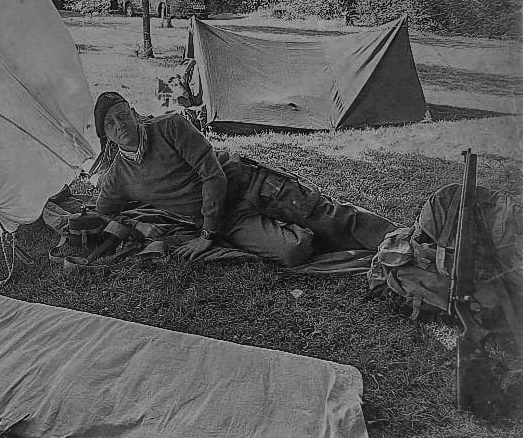
The "Bulbasket" research group's efforts in seeking information on the operation, those heros involved, and commemoration of the individuals and their bravery, is a credit to them.
_______________________
In the Summer of 1954, a British shooting journal passed comment on the Mossberg rifles,
still technically in military use although officially on loan from the U.S. Government. They wrote:
" Possibly the most maligned .22 rifle in Britain is the Mossberg. Many an unladylike word has been uttered by armourers trying to make them shoot accurately.
Imported under lease lend in our hour of need it was indeed a boom and a blessing. Thousands came to us from across the Atlantic and helped Home Guard and others to learn the rudiments of marksmanship. These weapons, by the way, cannot be obtained commercially, they are Government property and are now issued to the present Home Guard and to the several Cadet Corps.
For some inexplicable reason, whilst the Combined Cadet Force, the Army Cadet Force and the Air Training Corps have their rifles examined about twice a year by armoury experts, in the Sea Cadet Corps maintenence was the responsibility of local units. To what degree this stamping the butt of the rifle on to the ground is the cause of a very sad, fatal accident will never be established. The only son of a widow, an extremely keen Sea Cadet, was practising rifle drill at the firing point whilst his target was being placed at the butt. Ithn stamping the butt of the rifle on to the ground he discharged the weapon and shot himself.
Few rifles, loaded and cocked, will not accidentally fire if banged on the floor. Mr. Driberg, Member of Parliament for Maldon, Essex, was assured by the Parliamentary Secretary to the Ministry of Defence in the House of Commons recently, that the accident was the result of a breach of range discipline and that in future firearms issued to the Sea Cadet Corps will be inspected by competent armourers at frequent intervals. The foregoing remarks are made with reservations because it is understood that the Mossberg rifle in its present form is most effective, accurate and safe."
For the obviously stated reason, none of these rifle were then in civilian hands, but the spreading of such Lend-lease equipment widely around the country, to Home Guard and Cadet units, does explain why so many rifles marked "U.S. PROPERTY" found their way into associated civilian rifle clubs, and subsequently into private hands.
Many were indeed returned to the United States, and there factory refurbished, but not all of them by any means.
Mossberg also supplied a simple telescopic sight and an adequate, if rather agricultural, mounting arrangement.
Drag horizontally to rotate subject. Click to zoom and drag to pan. Full screen viewing from expansion arrows.
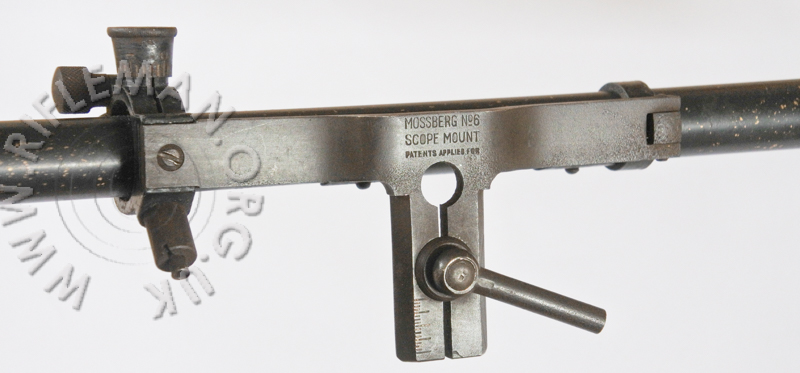
But the 'scope's fitment certainly filled a useful place in both the rifle's training and sporting capabilities.
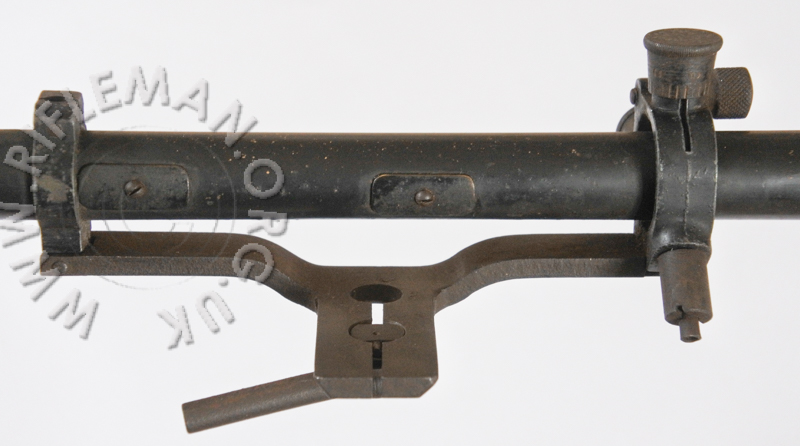
The design was no doubt borne out of the difficulty in mounting a plain tubular 'scope with fixed reticle,
there being only focus and parallax adjustment internally,
and providing the necessary elevation/windage adjustments
and quick release, while maintaining the rifle's original sighting configuration;
but improvements were made with the design of the mounts for the Model 44US training rifle.
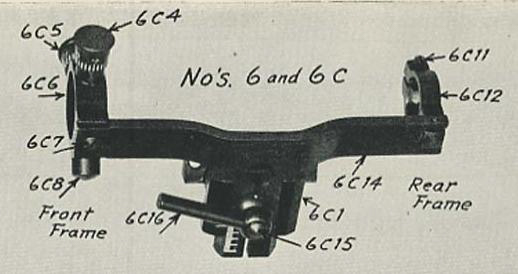
Image of part nos. by courtesy of the "Unofficial MOSSBERG Smallbore" site.
Mossberg " 46 M (b) " Post-War training rifle
Drag horizontally to rotate subject. Click to zoom and drag to pan. Full screen viewing from expansion arrows.
This rifle is 4 ounces heavier than the 42M models, now weighing 6 lbs. 14 ozs.,
and is fed by a tube magazine in the fore-end rather than by the removable clip box magazine of the 42M.

The cap for the spring-loaded feed-rod of the tube magazine can be seen on the nose of the fore-end.
The Mannlicher style of stocking has been retained from the 42M-B,
in fact it has been reported that the wood furniture may have been unused wartime stock,
although the trigger-guard, a plastic moulding that incorporates the shaped finger-grooves in the pistol-grip,
and which previously ran right to the bottom of the woodwork,
now stops with a radiussed end about a quarter-inch short of the base of the pistol-grip.
The butt-plate is now still a plastic moulding, without the spare magazine storage trap of the early 42M-B.

This particular rifle has been fitted with the Parker-Hale alternative rear-sight mentioned earlier on the page.

On the underside of the fore-end and butt-stock are the keyed slots for sling-swivels.
The angled slot for the loading of cartridges is about six inches to the rear of the fore-end nose.

Apart from previously covered aspects, little is different on the Model 46 from the models 42.
The barrel-mounted rear-sight, just ahead of the action is, though, very different.
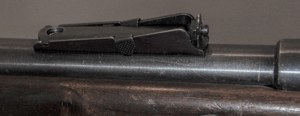
As is the plain fore-sight ramped block with a plain blade dovetailed for windage zeroing adjustment.
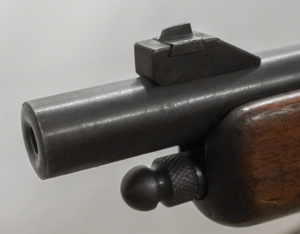
That's all folks, for the time being.
See also: imagery only (as yet) of the Model 44 US (d)
See also a: Chronology of Enfield genre Training Rifles, Adapters & Cartridges
See this website's Raison d'être